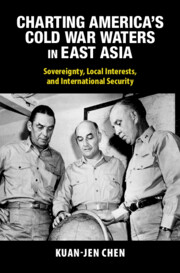 Charting America's Cold War Waters in East Asia
Charting America's Cold War Waters in East Asia Book contents
- Charting America’s Cold War Waters in East Asia
- Cambridge Studies in US Foreign Relations
- Charting America’s Cold War Waters in East Asia
- Copyright page
- Contents
- Figures, Tables, and Maps
- Abbreviations
- Conventions
- Acknowledgements
- Introduction
- 1 Finding a Local Partner in Post-war Maritime East Asia
- 2 The Creation of a Mainland-Based Forward Strategy
- 3 Vying for Top Dog: The Navy–Army Struggle in Maritime East Asia
- 4 Termination of the Mainland-Based Forward Strategy
- 5 The 1950 Crises and America’s Changing Posture of Defence
- 6 The Making of a New Maritime Strategy
- 7 The International Law of the Sea and America’s Unreliable Partners
- 8 America’s Strange Bedfellows in the International Arena
- 9 Fishing for Protein in Cold War East Asia
- 10 Jostling for Position: Black Gold, Natural Resource Exploration, and Shifting Political Contours
- Epilogue
- Bibliography
- Index
Epilogue
Published online by Cambridge University Press: 23 May 2024
- Charting America’s Cold War Waters in East Asia
- Cambridge Studies in US Foreign Relations
- Charting America’s Cold War Waters in East Asia
- Copyright page
- Contents
- Figures, Tables, and Maps
- Abbreviations
- Conventions
- Acknowledgements
- Introduction
- 1 Finding a Local Partner in Post-war Maritime East Asia
- 2 The Creation of a Mainland-Based Forward Strategy
- 3 Vying for Top Dog: The Navy–Army Struggle in Maritime East Asia
- 4 Termination of the Mainland-Based Forward Strategy
- 5 The 1950 Crises and America’s Changing Posture of Defence
- 6 The Making of a New Maritime Strategy
- 7 The International Law of the Sea and America’s Unreliable Partners
- 8 America’s Strange Bedfellows in the International Arena
- 9 Fishing for Protein in Cold War East Asia
- 10 Jostling for Position: Black Gold, Natural Resource Exploration, and Shifting Political Contours
- Epilogue
- Bibliography
- Index
Summary
History is the accumulation of human activities over time. Historians have sought ceaselessly to explore changes in, amongst other things, intellectual trends, cultures, materials, races, genders, political systems, and international politics. However, if we change the geographical space in which we examine history, will we reach the same conclusions? During my academic travels in East Asia, Europe, and the United States, the question that came up most often was what can we learn about Cold War history from a maritime perspective? Current scholarship shows us that the Cold War in East Asia took shape as the result of the standoff between the US and the USSR in respect of the military, ideology, political systems, and economic markets, amongst other things. But it cannot answer the question I encountered. This book, accordingly, invites its audience to rethink how the ocean – which was characterised as a geostrategic barrier – functions as a barometer that can allow one to comprehend the untold stories embedded in the interactions between the United States and its East Asian allies and enemies alike during the Cold War.
- Type
- Chapter
- Information
- Charting America's Cold War Waters in East AsiaSovereignty, Local Interests, and International Security, pp. 291 - 300Publisher: Cambridge University PressPrint publication year: 2024
